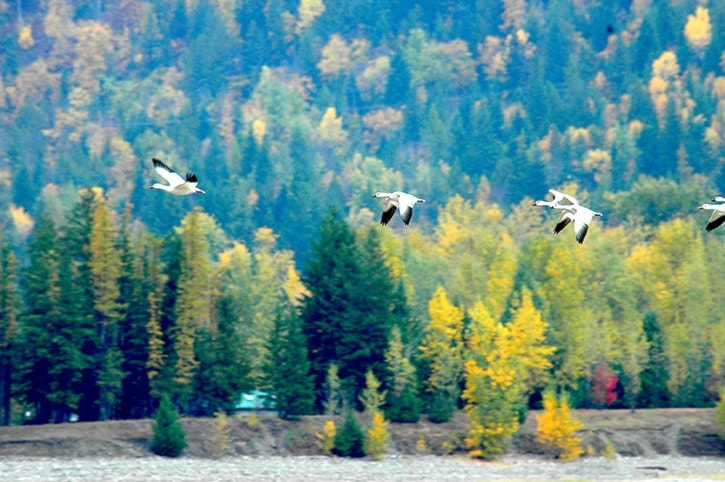Each year, usually in the spring or fall, I get a phone call from someone who has seen white birds flying along the lake. Sometimes the caller will assume they are swans, and sometimes they’re right. But these aren’t the only candidates.
We have two species of native swans in British Columbia: Tundra Swan and Trumpeter Swan. A third species, the Mute Swan, has been introduced into parks around the province and sometimes one or two will escape and fly free for a while, but they rarely last for very long. Both pass through our region during in migration, but never in large numbers and probably not every year. A couple of years ago, a few spent the entire winter at the north end of Slocan Lake, but it is unusual for swans to over-winter in our region.
But what of the other white birds? American White Pelicans breed in the Caribou region west of Williams Lake, but their migration route does not normally bring them as far east as our valley. Yet pelicans have been seen in both the Arrow and Slocan valleys. Like quite a few larger birds, pelicans do not achieve breeding age until they are three or four years old. That means that there are a lot of non-breeding birds wandering around. And sometimes, that’s exactly what they do, they wander around.
I have personally only seen pelicans in the region a few times, but I’ve heard of several other reports over the years. People who live right on the lake are much more likely to see them flying past.
A couple of other species of white birds are geese: Snow Goose and the slightly smaller Ross’ Goose. Both of these species breed in the Arctic, and most winter in the southern United States, though several thousand Snow Geese winter at the mouth of the Fraser River.
Geese flying from the western Arctic normally use routes closer to the coast. Those breeding in the central Arctic fly straight down through the prairies. As a result we are generally in between the two flyways and we don’t often see them pass this way. Ross’s Geese are seen even less often because virtually the entire population uses the Prairie flyway.
Despite all of this, last Friday I saw a small flock of white geese fly past the golf course at Fauquier. I assumed they were Snow Geese and at first didn’t even raise my binoculars. But after I’d sunk that four-foot putt, I dug the binoculars out of the golf bag and had a look. I was quite surprised to see that there were six Snow Geese and one Ross’ Goose! The difference in size is not great, but it stands out when you see them both together. This marks only the third time I’ve seen Ross’ Goose in the West Kootenay region.
If you are fortunate enough to be on the lake when large white birds fly by, look first to see if there is any black in the white wingtips. Swans have totally white wings; pelicans and geese have black wingtips. And please let me know if you do see them!
